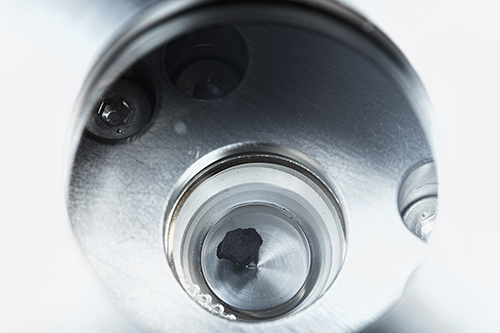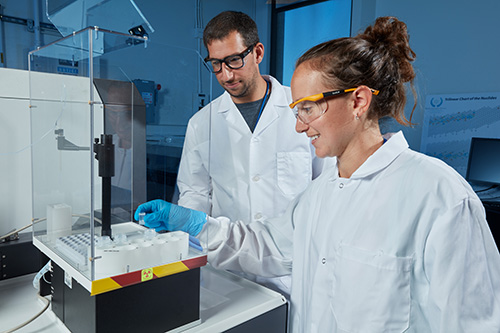Asteroid sample lands on LLNL
 (Download Image)
(Download Image)
Ziva Shulaker (the LLNL principal investigator) holding the Ryugu asteroid subsample in its sample capsule. Photos by Garry McLeod.
No need to worry, it is just a very small piece for scientific study.
In December 2014, the Japanese Aerospace Exploration Agency launched the spacecraft Hayabusa2 to the asteroid 162173 Ryugu. In December 2020, when the sample-return capsule successfully landed safely back on Earth with pristine pieces of Ryugu that it had collected, Lawrence Livermore National Laboratory (LLNL) cosmochemists were on high alert. They got to work on a proposal to receive a subsample of the asteroid. And that material is now on site at LLNL.
Ryugu is an ancient fragment of a larger asteroid that formed very early in solar system history, shortly after the birth of the sun. Samples from this asteroid present a unique opportunity to determine not only the material the solar system formed from, but also how the solar system evolved.
The solar system formed from a large cloud of swirling gas and dust made by previous generations of stars. This “stardust” is nanometer to micrometer sized particles that are incorporated into planetary bodies, like Ryugu, when they form.
“Studying stardust in Ryugu is instrumental to determine the origin of the material including the different types of stars that contributed to the parent body of Ryugu, and therefore our solar system,” said Ziva Shulaker, the LLNL principal investigator of the project.
The isotopic composition of stardust is a geochemical fingerprint of the stellar environments from which the stardust formed (e.g., the type of star as well as its mass, temperature and neutron density at the time of stardust formation).
The conventional method used to obtain stardust from meteorites was to dissolve essentially the entire sample, leaving only the particles behind. However, dissolving everything but the stardust wastes a lot of sample material.
Zoomed-in image showing the dark coloration of the Ryugu asteroid sample. For scale, the capsule is 6 cm in diameter.To preserve as much material as possible from such a precious sample, the LLNL team is developing nondestructive sample preparation techniques. Micro-computed tomography (Micro-CT) imaging of the sample will be used to locate stardust. Then, individual particles will be removed for mass spectrometer analysis to probe their isotopic compositions. These isotopic datasets will be used to constrain physical conditions, density, temperature and timescale of element creation in the parent stars.
To reconstruct the more recent history of our solar system, the relationship of Ryugu to other bodies in the solar system must be established.
“We are using the previously measured chemical and isotopic signatures of different bodies in the solar system to compare these pieces of Ryugu and to see how they fit together,” said Quinn Shollenberger, LLNL scientist in charge of relating Ryugu to Earth and other known samples in the world’s meteorite collections to understand solar system formation. “We are trying to better understand how Earth formed and evolved into what it is today.”
Cosmochemists Jan Render (left) and Quinn Shollenberger (right) prepare samples to be measured utilizing multi collector inductively coupled plasma mass spectrometry.Because Ryugu is a uniquely pristine sample without terrestrial contamination, bulk-rock measurements of Ryugu can establish genetic relationships to planetary bodies and refine the accretion history of the terrestrial planets. Ryugu is closely related to C1 chondrites, which are believed to best represent the bulk solar system composition, and therefore the sun.
The LLNL team will use the bulk-sample iron isotopic composition of Ryugu to test whether Earth formed from material similar to Ryugu. Complimentary bulk-sample titanium, chromium and nickel isotopics also will be collected to understand the speed and conditions of Earth’s accretion from a protoplanetary disk.
LLNL cosmochemists Greg Brennecka, Jan Render, Lars Borg, Michael Savina and Wei Jia Ong also are part to the team.
The work conducted by the LLNL team provides a unique opportunity to gain comprehensive insight into what the solar system formed from and how the solar system – and Earth – has evolved since its formation.
Contact
 Anne M. Stark
Anne M. Stark
[email protected]
(925) 422-9799
Related Links
Japanese Aerospace Exploration AgencyHayabusa2
Tags
Nuclear, Chem, and Isotopic S&TNuclear and Chemical Sciences
Space Science Institute
Physical and Life Sciences
Featured Articles









